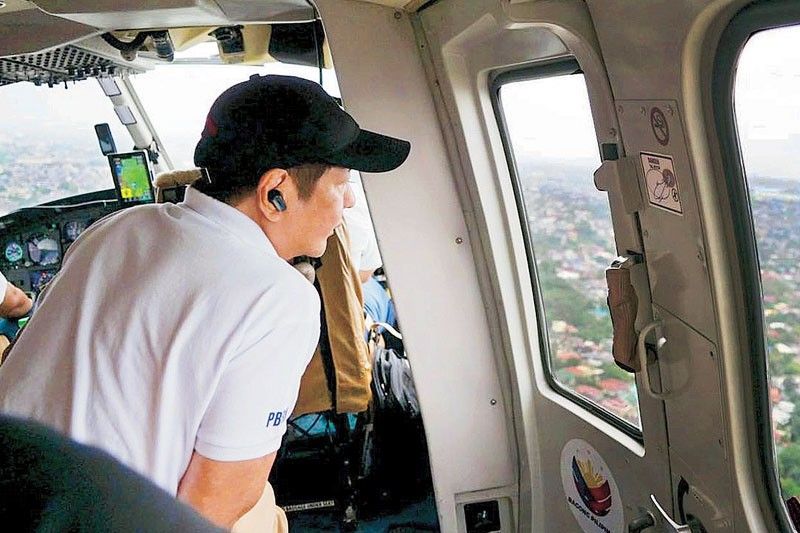President Marcos wants flood control masterplan

MANILA, Philippines — The country needs to have a flood control masterplan as it braces for more torrential rain during the typhoon season that is expected to be worsened by the looming La Niña and climate change, President Marcos said yesterday.
Marcos visited and inspected Quezon and Rizal, two of the provinces inundated by incessant rains from Typhoon Carina and the enhanced southwest monsoon-induced rains in the past days.
“Water doesn’t recognize boundaries. That’s why flood control has to be a big plan,” Marcos said.
He said the comprehensive national plan on flood control should cover several regions, adding it also needs to consider the changing weather patterns due to climate change that threaten communities which previously have not been affected by floods.
“Let’s prepare for the next flood. This is the first typhoon within La Niña. This might be prolonged. So, we have to prepare for that. Let’s think about preparing for that,” the President said.
According to Marcos, former public works and highways secretary Rogelio Singson has crafted a flood management masterplan that would be implemented over more than two decades. But the plan should be expanded, he said.
“Although it will work... and it crosses most of Luzon, for the NCR (National Capital Region). But we have no choice, we have to do something. We have to learn how to handle the new normal,” the Chief Executive said, adding the plan would take 20 to 22 years.
Marcos was referring to the P350-billion flood control masterplan, which was expected to benefit about 1.2 million people.
The President said because of sea level rise caused by climate change, the dikes built across the country could no longer protect low-lying communities during high tides.
Building higher dikes, however, would not solve the problem, Marcos said, adding the flood control masterplan must manage flooding to protect “production areas, residential communities and other important infrastructure.”
The President also expressed hope the country could tap assistance from the Loss and Damage Fund to find better solutions to flooding and other effects of climate change.
Meanwhile, Rizal Gov. Nina Ynarez told Marcos that the newly inaugurated Upper Wawa Dam in Rodriguez, Rizal was filled by two days of nonstop rain.
“We were together with the inauguration of Wawa Dam and they were saying that…we saw it was empty and it would take six months for them to fill it up. As of now, with the two days’ rain, it’s almost filled up,” Ynarez said.
Ynarez said without the Wawa Dam, “most likely San Mateo and Montalban would be down and definitely Marikina and parts of Quezon City and even Pasig would be affected because of Laguna Lake.”
The governor said they submitted last year to the Department of Public Works and Highways (DPWH) a plan for a reservoir below the Wawa Dam.
Public Works Secretary Manuel Bonoan, who was among the Cabinet secretaries who joined Marcos in Rizal, said the proposed reservoir in San Mateo and a series of small dams below Wawa “is now under consideration for financing by the Japanese government.”
Marcos also directed a study on the building of weirs along tributaries to control the water flow from Sierra Madre down to Rizal and Metro Manila, as unimpeded water flow causes severe flooding during rainy season.
A weir is a small barrier built across a stream or river to control and raise the water level slightly on the upstream side, essentially a small-scale dam.
“I don’t see a weir here in this country which seems to be appropriate for us…Maybe it’s applicable here in the Philippines,” the President said.
Metro drainage
The proposed 50-year drainage masterplan for Metro Manila is still in the works, Metropolitan Manila Development Authority said.
MMDA general manager Procopio Lipana said the agency has submitted the masterplan’s terms of reference to the DPWH that could help create and implement it.
The masterplan would determine the “detailed engineering design” of drainage systems in the entire Metro Manila, according to MMDA Acting Chairman Romando Artes in previous interviews late last year.
He added it would seek to prevent unstable flow of excess water due to varying sizes of drainages.
The proposed 50-year drainage masterplan would be funded by World Bank.
During the torrential rains from the southwest monsoon carried by Typhoon Carina, the MMDA reported existing drainage systems in Metro Manila carried 74 mm per hour for more than 10 hours.
The figure was more than twice the carrying capacity of drainages at 30 mm per hour, it noted.
Lipana said that with rainfall from the southwest monsoon that allegedly exceeded that of Typhoon Ondoy in 2009, both drainages and pumping stations operated by the MMDA could have been overwhelmed by such a volume that was “beyond their capacity.”
However, except for the Libertad pumping station that caught fire, the rest of the 71 pumping stations remained operational during the incessant rainfall, he added.
He also blamed garbage for the widespread flooding in the metropolis, as well as the lack of discipline of residents – particularly those living near waterways – in disposing their trash. He mentioned the incident wherein flooding along EDSA near the old MMDA building in Makati City subsided after the agency’s personnel performed declogging and retrieved waste from nearby drainage.
Budget
Sen. Grace Poe questioned the bloated budget for flood control projects which still failed to curb the flooding in Metro Manila and nearby areas after Typhoon Carina.
“The worsening flooding in Metro Manila appears not to complement the increasing budget we are allocating for flood control projects every year,” Poe, a former public services committee chair, said yesterday.
Poe vowed to scrutinize the proposed flood control budget next year of the DPWH and the MMDA.
Poe is the new Senate finance committee chair, taking on the position vacated by former senator now Education Secretary Sonny Angara.
The finance committee is tasked to tackle the national government expenditure program.
“In the upcoming budget deliberation, we will scrutinize the flood control budget of the DPWH, MMDA and other agencies. Did the flood just flush away the billions of funds for flood mitigation?” Poe asked.
“With every downpour, our taxpayers are left shortchanged and wading through damaging and disease-carrying floods,” she added.
According to the 2024 General Appropriations Act, DPWH has a P244.6-billion budget in its flood management program, a significant chunk of its total P996.79-billion budget this year.
During the budget deliberations last year, then senator now Senate President Francis Escudero hit the DPWH’s proposed P255-billion flood control budget, which surpassed the total proposed budget of other agencies like the Department of National Defense and the Department of Social Welfare and Development. — Bella Cariaso, Ghio Ong, Marc Jayson Cayabyab, Art Dumlao, Ramon Efren Lazaro
- Latest
- Trending




























